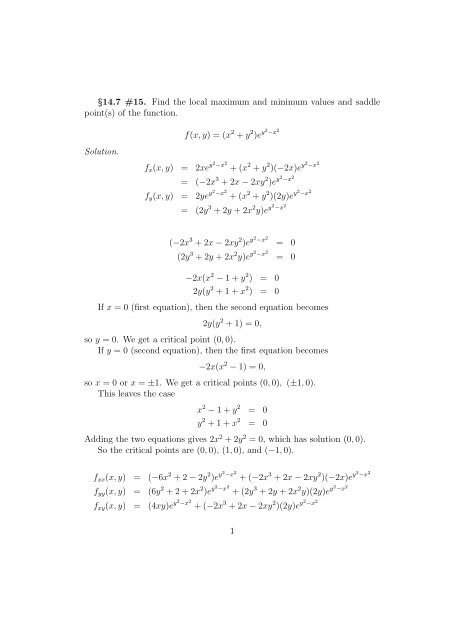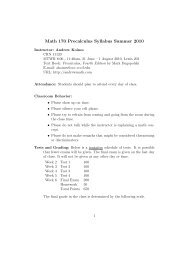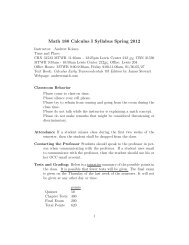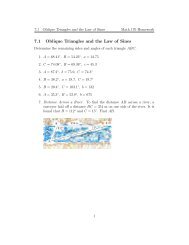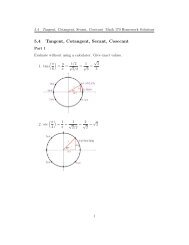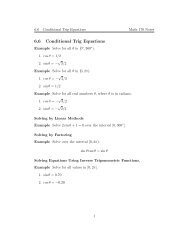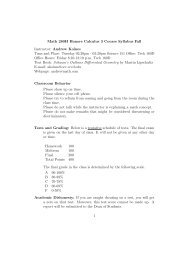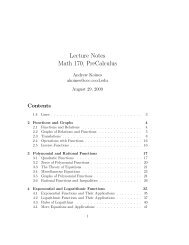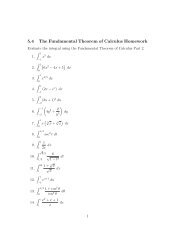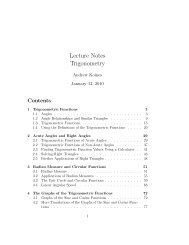(x2 + y2)ey2-x2 Solution. fx
(x2 + y2)ey2-x2 Solution. fx
(x2 + y2)ey2-x2 Solution. fx
You also want an ePaper? Increase the reach of your titles
YUMPU automatically turns print PDFs into web optimized ePapers that Google loves.
§14.7 #15. Find the local maximum and minimum values and saddle<br />
point(s) of the function.<br />
<strong>Solution</strong>.<br />
f(x, y) = (x 2 + y 2 )e <strong>y2</strong> −x 2<br />
<strong>fx</strong>(x, y) = 2xe <strong>y2</strong>−<strong>x2</strong> + (x 2 + y 2 )(−2x)e <strong>y2</strong>−<strong>x2</strong> = (−2x 3 + 2x − 2xy 2 )e <strong>y2</strong> −x 2<br />
fy(x, y) = 2ye <strong>y2</strong>−<strong>x2</strong> + (x 2 + y 2 )(2y)e <strong>y2</strong>−<strong>x2</strong> = (2y 3 + 2y + 2x 2 y)e <strong>y2</strong> −x 2<br />
(−2x 3 + 2x − 2xy 2 )e <strong>y2</strong> −x 2<br />
(2y 3 + 2y + 2x 2 y)e <strong>y2</strong> −x 2<br />
−2x(x 2 − 1 + y 2 ) = 0<br />
2y(y 2 + 1 + x 2 ) = 0<br />
= 0<br />
= 0<br />
If x = 0 (first equation), then the second equation becomes<br />
2y(y 2 + 1) = 0,<br />
so y = 0. We get a critical point (0, 0).<br />
If y = 0 (second equation), then the first equation becomes<br />
−2x(x 2 − 1) = 0,<br />
so x = 0 or x = ±1. We get a critical points (0, 0), (±1, 0).<br />
This leaves the case<br />
x 2 − 1 + y 2 = 0<br />
y 2 + 1 + x 2 = 0<br />
Adding the two equations gives 2x 2 + 2y 2 = 0, which has solution (0, 0).<br />
So the critical points are (0, 0), (1, 0), and (−1, 0).<br />
<strong>fx</strong>x(x, y) = (−6x 2 + 2 − 2y 2 )e <strong>y2</strong>−<strong>x2</strong> + (−2x 3 + 2x − 2xy 2 )(−2x)e <strong>y2</strong>−<strong>x2</strong> fyy(x, y) = (6y 2 + 2 + 2x 2 )e <strong>y2</strong>−<strong>x2</strong> + (2y 3 + 2y + 2x 2 y)(2y)e <strong>y2</strong>−<strong>x2</strong> <strong>fx</strong>y(x, y) = (4xy)e <strong>y2</strong>−<strong>x2</strong> + (−2x 3 + 2x − 2xy 2 )(2y)e <strong>y2</strong>−<strong>x2</strong> 1
• Critical point (0, 0).<br />
<strong>fx</strong>x(0, 0) = 2, fyy(0, 0) = 2, <strong>fx</strong>y(0, 0) = 0<br />
<br />
<br />
D(0, 0) = <br />
<strong>fx</strong>x<br />
<br />
<strong>fx</strong>y <br />
<br />
=<br />
<br />
<br />
2<br />
0<br />
<br />
0 <br />
<br />
2 = 4 > 0<br />
fyx fyy<br />
For the critical point (0, 0), D(0, 0) = 4 > 0, <strong>fx</strong>x(0, 0) = 4 > 0, therefore<br />
(0, 0) is a local minimum. We have f(0, 0) = 0.<br />
• Critical points (±1, 0).<br />
<strong>fx</strong>x(±1, 0) = −4, fyy(±1, 0) = 2, <strong>fx</strong>y(±, 0) = 0<br />
<br />
<br />
D(±1, 0) = <br />
<strong>fx</strong>x<br />
<br />
<strong>fx</strong>y <br />
<br />
=<br />
<br />
<br />
−4<br />
0<br />
<br />
0 <br />
<br />
2 = −8 < 0<br />
fyx fyy<br />
For the critical points (±1, 0), D(±1, 0) = −8 < 0, therefore (±1, 0)<br />
are saddle points. We have f(±1, 0) = 1/e.<br />
2


